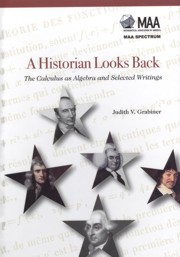Book contents
- Frontmatter
- Contents
- Introduction
- Part I The Calculus as Algebra
- Part II Selected Writings
- 1 The Mathematician, the Historian, and the History of Mathematics
- 2 Who Gave You the Epsilon? Cauchy and the Origins of Rigorous Calculus
- 3 The Changing Concept of Change: The Derivative from Fermat to Weierstrass
- 4 The Centrality of Mathematics in the History of Western Thought
- 5 Descartes and Problem-Solving
- 6 The Calculus as Algebra, the Calculus as Geometry: Lagrange, Maclaurin, and Their Legacy
- 7 Was Newton's Calculus a Dead End? The Continental Influence of Maclaurin's Treatise of Fluxions
- 8 Newton, Maclaurin, and the Authority of Mathematics
- 9 Why Should Historical Truth Matter to Mathematicians? Dispelling Myths while Promoting Maths
- 10 Why Did Lagrange “Prove” the Parallel Postulate?
- Index
- About the Author
8 - Newton, Maclaurin, and the Authority of Mathematics
from Part II - Selected Writings
- Frontmatter
- Contents
- Introduction
- Part I The Calculus as Algebra
- Part II Selected Writings
- 1 The Mathematician, the Historian, and the History of Mathematics
- 2 Who Gave You the Epsilon? Cauchy and the Origins of Rigorous Calculus
- 3 The Changing Concept of Change: The Derivative from Fermat to Weierstrass
- 4 The Centrality of Mathematics in the History of Western Thought
- 5 Descartes and Problem-Solving
- 6 The Calculus as Algebra, the Calculus as Geometry: Lagrange, Maclaurin, and Their Legacy
- 7 Was Newton's Calculus a Dead End? The Continental Influence of Maclaurin's Treatise of Fluxions
- 8 Newton, Maclaurin, and the Authority of Mathematics
- 9 Why Should Historical Truth Matter to Mathematicians? Dispelling Myths while Promoting Maths
- 10 Why Did Lagrange “Prove” the Parallel Postulate?
- Index
- About the Author
Summary
Introduction: Maclaurin, the Scottish Enlightenment, and the “Newtonian Style”
Sir Isaac Newton revolutionized physics and astronomy in his book Mathematical Principles of Natural Philosophy [27]. This book of 1687, better known by its abbreviated Latin title as the Principia, contains Newton's three laws of motion, the law of universal gravitation, and the basis of all of classical mechanics. As one approaches this great work, a key question is: How did Newton do all of this? An equally important question is: Can Newton's methods work on any area of inquiry? Newton's contemporaries hoped that the answer to the second question was yes: that his methods would be universally effective, whether the area was science, society, or religion. What are the limits of the Newtonian method? In 1687, nobody knew. But his followers wanted to find out, and they tried to find out by applying these methods to every conceivable area of thought.
In Great Britain, Newton's most successful follower was Colin Maclaurin (1698–1746). Maclaurin was the most significant Scottish mathematician and physicist of the eighteenth century, and was highly influential both in Britain and on the Continent. He was one of the key figures in what is called the Scottish Enlightenment, the eighteenth-century intellectual movement that includes philosophers like Francis Hutcheson and David Hume, scientists like James Hutton and Joseph Black, and social philosophers like Adam Smith [3], [31]. And I have come to think that Newton's method—what has been called “the Newtonian style”—is both the key to understanding what made Maclaurin tick intellectually and to understanding the nature of his influence. In this paper, I want to demonstrate these conclusions.
- Type
- Chapter
- Information
- A Historian Looks BackThe Calculus as Algebra and Selected Writings, pp. 229 - 242Publisher: Mathematical Association of AmericaPrint publication year: 2010



